After being coerced into reading Harry Potter by a couple of friends, I was inspired to make sweaters for said friends. Not just any sweaters though; these were Weasley sweaters, modeled after those that Mrs. Weasley makes as gifts for each of her family members (and Harry) every Christmas. In the books these sweaters are described as being boxy, over-sized, and bearing the first initial of the recipient…. That’s not much to go on if you’ve never made a sweater before. Luckily, a more experienced knitter (Alison Hansel) had already devised a pattern, and graciously posted it online for free. Check it out. In my endeavors with this pattern, I found it necessary to make a few adjustments, which I’ll explain below with the featured images.
One more quick note about making sweaters, if you’re a novice: It takes for freaking ever. Unless you’ve got enchanted knitting needles like Mrs. Weasley, you’re going to be spending a lot of hours on this project. I made the mistake of promising these sweaters as Christmas gifts, and ended up having them done for my friends’ birthdays (both of which are in August — oof). So yeah, unless you have a significant amount of free time each day, perhaps don’t give yourself a deadline! That being said, I’ve been assured these sweaters are worth the wait.
Sweater #1, for H. I’m the one modelling in this pic, but H is my size, so this is an accurate representation of the fit. This sweater was an adult medium. I am writing up this post two years (eek) after I gave away my creations, and unfortunately it appears that I did not take pictures of sweater #2. This second sweater featured an S, which was quite a complicated letter to devise a patter for. I turned to the internet for basic letter S knitting patterns in order to get an idea of the dimensions and ratios. Neither sweater featured the suggested yarn or colors. As long as the yardage and weight are correct, I buy whatever yarn I want!
Hansel’s pattern offers both child and adult sizes for the sweater, however, only two sizes of the letter H are demonstrated: one for a child’s small and another for every other size. A 32 by 22 stitch letter may look fine on a medium-sized child, but it’s going to look quite different on an XXL adult. I grabbed some graphing paper and a pencil and beefed out the “H”. For my adult medium sweater I ended up with a 32 x 32 stitch “H” with lines that were double the suggested width (4 rows instead of 2, 6 stitches instead of 3, etc.). I highly recommend adjusting the pattern to taste in this regard, and Hansel makes it easy. She offers directions for two methods of adding the initial: intarsia (in layman’s terms: changing colors as you go), or duplicate stitch (adding the letter in the second color onto the finished piece). I used the intarsia method without much forethought, but if you’re hesitant to knit up your altered pattern without knowing how the proportions will look, then I recommend adding the letter on after, using the duplicate stitch method.
The stockinette stitch pattern creates this nice rolling of the hem and collar. On the collar, this rolling conveniently masks the seam of where the shoulder and neck are joined together.
The cuffs are tapered with a knit 2, purl 2 ribbing. If I had to make another of these sweaters (not for a while, please), I would consider adopting this ribbing for the hem as well. That would follow my personal preference to feel that the hem of my top was grounded.
When I made this sweater, I was very inexperienced at joining pieces together. Consequently, when I picked up stitches to start the arms, I thought I needed to pick up each consecutive loop until I had the corresponding number of stitches. This might work for some people, but unfortunately my loose knitting created this bunching of material that you see above. Now I know that I should have factored in my gauge.
For example, the sleeves for the child’s small require 60 stitches. Instead of picking up 60 stitches straight, I would take a measurement from some of my finished work, to figure out how many inches 60 stitches would be. Let’s say it was 20 inches (that’s more than the suggested gauge of 15″). I would measure 10″ down from the shoulder seam on the front, and 10″ down from the shoulder seam on the back, and in between those two marks I would pick up 60 stitches. Complicated, but a necessary calculation to make if you don’t knit to the gauge, and care about bunching.
H said her sweater was worth the wait, and her enthusiasm made it worth the work!
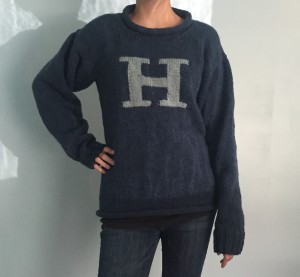
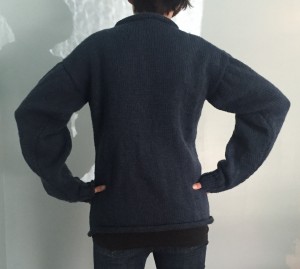
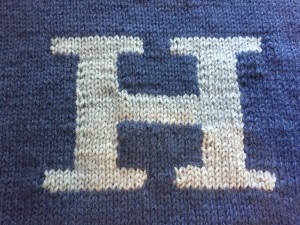
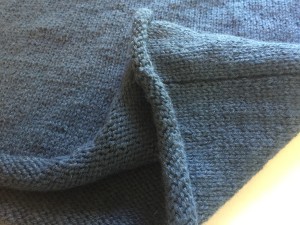
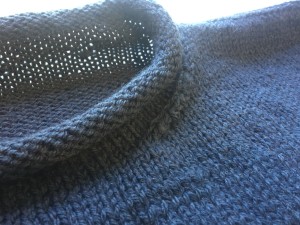
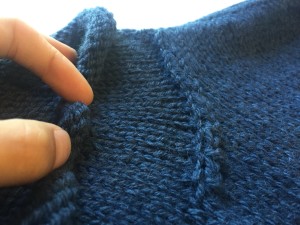
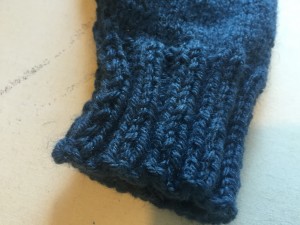

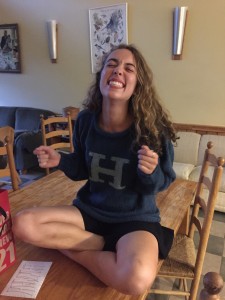
Lovely sweater!